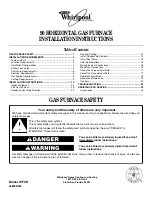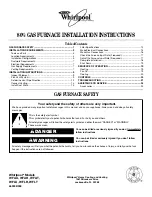
21
Table 1 – Opening Dimensions -- In. (mm)
FURNACE
CASING
WIDTH
APPLICATION
(APPROVED FACTORY SUPPLIED CASED COILS AND
COIL BOX: CD5, CKR, CAPVP, CARVP, CAPMP, CARMP,
CNPVP, CNRVP, AND KCAKC)
PLENUM OPENING
FLOOR OPENING
A
B
C
D
17
½
(445)
Upflow Applications on Combustible or Noncombustible
Flooring (KGASB subbase not required)
16
(406)
24---1/8
(613)
16---5/8
(422)
24---3/4
(629)
Downflow Applications on Noncombustible Flooring (KGASB
subbase not required)
15---7/8
(403)
19
(483)
16---1/2
(419)
19---5/8
(498)
Downflow applications on combustible flooring
(KGASB
subbase
required)
15---1/8
(384)
19
(483)
16---3/4
(425)
20---3/8
(518)
Downflow Applications on Combustible Flooring with Factory
supplied cased coil or Factory supplied coil box (KGASB
subbase not required)
15---1/2
(394)
19
(483)
16---1/2
(419)
20
(508)
21
(533)
Upflow Applications on Combustible or Noncombustible
Flooring (KGASB subbase not required)
19---1/2
(495)
24---1/8
(613)
20---1/8
(511)
24---3/4
(629)
Downflow Applications on Noncombustible Flooring (KGASB
subbase not required)
19---3/8
(492)
19
(483)
20
(508)
19---5/8
(498)
Downflow applications on combustible flooring
(KGASB
subbase
required)
18---5/8
(473)
19
(483)
20---1/4
(514)
20---3/8
(518)
Downflow Applications on Combustible Flooring with Factory
supplied cased coil or Factory supplied coil box (KGASB
subbase not required)
19
(483)
19
(483)
20
(508)
20
(508)
24---1/2
(622)
Upflow Applications on Combustible or Noncombustible
Flooring (KGASB subbase not required)
23
(584)
24---1/8
(613)
23---5/8
(600)
24---3/4
(629)
Downflow Applications on Noncombustible Flooring (KGASB
subbase not required)
22---7/8
(581)
19
(483)
23---1/2
(597)
19---5/8
(498)
Downflow applications on Combustible flooring
(KGASB
subbase
required)
22---1/8
(562)
19
(483)
23---3/4
(603)
20---3/8
(518)
Downflow Applications on Combustible Flooring with Factory
supplied cased coil or Factory supplied coil box (KGASB
subbase not required)
22---1/2
(572)
19
(483)
23---1/2
(597)
20
(508)
AIR DUCTS
General Requirements
The duct system should be designed and sized according to
accepted national standards such as those published by: Air
Conditioning Contractors Association (ACCA), Sheet Metal and
Air Conditioning Contractors National Association (SMACNA) or
American Society of Heating, Refrigerating and Air Conditioning
Engineers (ASHRAE) or consult
The Air Systems Design
Guidelines
reference tables available from your local distributor.
The duct system should be sized to handle the required system
design CFM at the design static pressure.
When a furnace is installed so that the supply ducts carry air
circulated by the furnace to areas outside the space containing the
furnace, the return air must also be handled by a duct(s) sealed to
the furnace casing and terminating outside the space containing the
furnace.
Secure ductwork with proper fasteners for type of ductwork used.
Seal supply-- and return--duct connections to furnace with code
approved tape or duct sealer.
Flexible connections should be used between ductwork and
furnace to prevent transmission of vibration. Ductwork passing
through unconditioned space should be insulated to enhance
system performance. When air conditioning is used, a vapor barrier
is recommended.
Maintain a 1--in. (25 mm) clearance from combustible materials to
supply air ductwork for a distance of 36 in. (914 mm) horizontally
from the furnace. See NFPA 90B or local code for further
requirements.
For a furnace not equipped with a cooling coil, the outlet duct shall
be provided with a removable access panel. This opening shall be
accessible when the furnace is installed and shall be of such a size
that the heat exchanger can be viewed for possible openings using
light assistance or a probe can be inserted for sampling the air
stream. The cover attachment shall prevent leaks.
Ductwork Acoustical Treatment
Metal duct systems that do not have a 90 degree elbow and 10 ft.
(3M) of main duct to the first branch take--off may require internal
acoustical lining. As an alternative, fibrous ductwork may be used
if constructed and installed in accordance with the latest edition of
SMACNA construction standard on fibrous glass ducts. Both
acoustical lining and fibrous ductwork shall comply with NFPA
90B as tested by UL Standard 181 for Class 1 Rigid air ducts.
Supply Air Connections
Upflow Furnaces
Connect supply--air duct to 3/4--in. (19 mm)flange on furnace
supply--air outlet. The supply--air duct attachment must ONLY be
connected to furnace supply--/outlet--air duct flanges or air
conditioning coil casing (when used). DO NOT cut main furnace
casing to attach supply side air duct, humidifier, or other
accessories. All accessories MUST be connected external to
furnace main casing.
Downflow Furnaces
Connect supply--air duct to supply--air opening on furnace. The
supply--air duct attachment must ONLY be connected to furnace
supply/outlet or air conditioning coil casing (when used) when
installed on non--combustible material
When installed on
combustible material, supply air duct attachment must ONLY be
connected to an accessory subbase or factory approved air
conditioning coil casing. DO NOT cut main furnace casing to
attach supply side air duct, humidifier, or other accessories. All
accessories MUST be connected external to furnace main casing.
Supply air opening duct flanges must be modified per Fig. 22.
Horizontal Furnaces
Connect supply--air duct to supply--air opening on furnace. The
supply--air duct attachment must ONLY be connected to furnace
supply/outlet or air conditioning coil casing (when used). DO NOT
cut main furnace casing to attach supply side air duct, humidifier,
58MV
C
















































